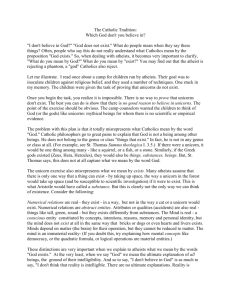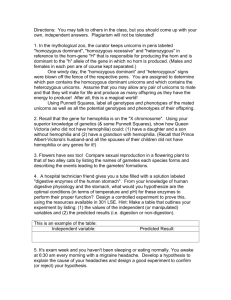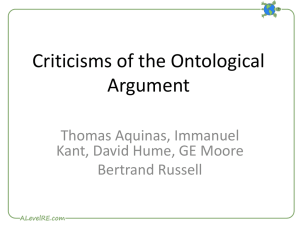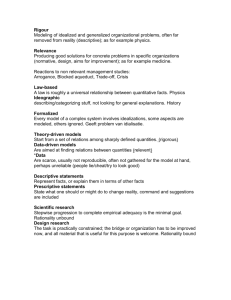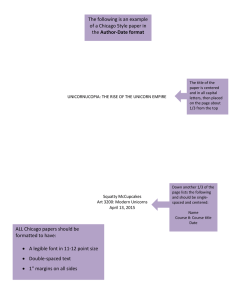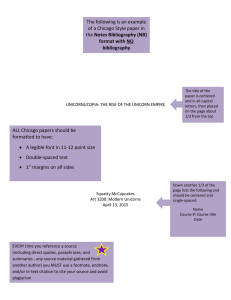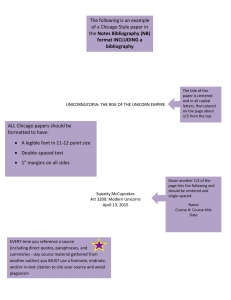3/15/09 doc version
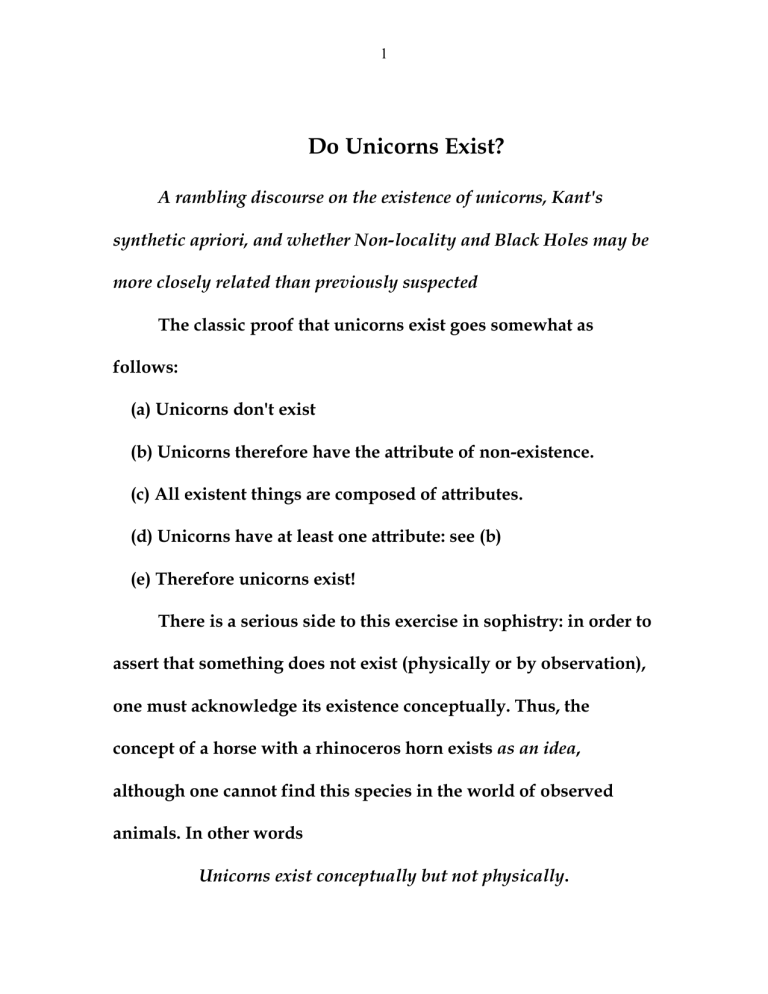
1
Do Unicorns Exist?
A rambling discourse on the existence of unicorns, Kant's synthetic apriori, and whether Non-locality and Black Holes may be more closely related than previously suspected
The classic proof that unicorns exist goes somewhat as follows:
(a) Unicorns don't exist
(b) Unicorns therefore have the attribute of non-existence.
(c) All existent things are composed of attributes.
(d) Unicorns have at least one attribute: see (b)
(e) Therefore unicorns exist!
There is a serious side to this exercise in sophistry: in order to assert that something does not exist (physically or by observation), one must acknowledge its existence conceptually. Thus, the concept of a horse with a rhinoceros horn exists as an idea, although one cannot find this species in the world of observed animals. In other words
Unicorns exist conceptually but not physically.
2
From what I can see, at least 4 different kinds of existential predicate are needed. By extension this would imply the necessity for 4 universal predicates, all with their negations, etc.
The first kind of predicate is “X exists empirically”. This usually means that it’s been observed by someone; however, in the context of a work of fiction or a thought experiment, “reality” can be a definition, that is to say a conception, relative to which one could define conceptual entities. In the normal workaday activity of the sciences, one assumes the existence of some kind of universal physical reality we can all agree on, like the existence of
New York City, apples, the inevitability of death (and taxes!) or the lost manuscripts of the music of Johann Adolph Hasse, (most of which were destroyed by the bombing of Dresden in the 7 Years
War).
Let us use the notation
X to signify “X exists in reality”,
R or “X exists empirically”. This can be temporally modified into 3 other predicates :
N
R
X “X exists now”,
P
R
X ”X really existed in the past” , and
F
X “X will really exist in the future” .
R
3
The existential quantifiers derivable from
R
X are its modifications. In fact,
R
X cannot be stated apart from its
The other form of the existential predicate is “X exists as a concept”. Note that X must exist conceptually in the present for it to exist empirically in the future:
R
F
X
C
N
X
It is usually the case that one must posit the existence of
For example, to assert that unicorns don’t exist one must be able to conceptualize a unicorn before one asserts that it doesn’t exist.
The existence of an entity Y that can be conceptualized can be notated as
C
Y .
Among these one can also distinguish several categories: those that don’t exist empirically but could or could have, those that can’t exist empirically, and those that can’t even exist
conceptually because they contain internal contradictions. Thus, one can say that a “round square” does not even exist conceptually
4 because it is internally inconsistent, or that a set that contains itself cannot exist conceptually because it contradicts the axioms of set theory.
Among those things which can exist conceptually but may or may not exist “in reality” are definitions, and back extensions of models of axiom schemes for which there may or may not be models. Here is a simple example:
The exponential Exp(x) is a natural isomorphism between the set of all real numbers, R, under addition (+), and the set of all positive real numbers R + under multiplication (x).
Let H be a “hybrid structure” consisting of the positive numbers under multiplication, and the semi-group of negative numbers under addition. Now the isomorphism of exponentiation (or the logarithm) allows us to back induce a new structure H*, consisting of the real numbers under addition, and a new set of numbers
that have no analogue in ordinary arithmetic, which is isomorphic to the semi-group of the negative numbers under some operation which relates to addition as addition relates to multiplication:
H
R
(
)
R
(
)
H *
ln H
K
(
*)
R (
)
5 where K is a set of conceptual objects and (+*)a conceptual
“addition” that have been derived through back extension on the operations of H. Does K “exist.” Yes, conceptually. Does it have a model in the real world? Only by virtue of the “natural equivalence” that links H* to H.
Gödelian subtleties about the existence of entities such as the real number system, which by their structure cannot be proven to be consistent, will not concern us here, except to say there are many ways in which the conceptual existence quantifier
C
Y can or must be modified and extended.
Psychology will also not enter into the concerns of this brief communication. Emotions are the somatic expression of mental states, and it isn’t clear how either my empirical or conceptual quantifiers can be applied to them. Problems of this sort, which touch on “intentionality” are treated in my article
“Logical and Psychological Question Theory” which one can read at www.fermentmagazine.org/Question.doc
or www.fermentmagazine.org/Question.pdf
.
6
Let’s see what happens with the universal quantifiers. Clearly
“All crows are black” or “All apples come from apple trees” are the universal equivalents of the negations of the empirically quantified statement: “There do not exist crows which are not black”
C
Z
C
Z
How does this play out with respect to conceptual universal quantifiers? What about statements like “All unicorns have a single twisted horn on their foreheads”? This is true, even though unicorns don’t exist in reality, but come out of the definition of a unicorn, which we assume to be conceptualizable. Could one argue that a unicorn may exist conceptually which lost its horn in a fight with another unicorn, and therefore became a horse, which we know to exist empirically ? Such dialectic pyrotechnics are not a part of the training of a logician who was not born in the 12 th century!
But what about “All round squares have a finite area?” One must assert this to be a “non-conceptualizable universal statement” because round squares do not exist even conceptually.
7
Using this simple framework it is easy to understand the problem that Immanuel Kant sets out to solve in the Critique of
Pure Reason, although its solution, with which one may or may not agree, covers hundreds of pages of dense argumentation.
Define the set of empirically existent objects as those which are contingent on the categories of space, time, substance and causation, and perhaps number and geometry. Note that
“observation” is not one of the requirements. An Ice Age in the future exists empirically, although it cannot be proven that it will ever occur. There may be a butterfly in my bathroom, although I’ve never seen one there.
Conceptually existent entities are outside the empirical categories. They “exist” apart from any attribution of location, duration, etc. One can argue as to whether “unicorns” fit this description. This depends on how much leeway one wishes to given to the concept of a concept. One might perhaps separate the notions of “concept” and “idea” and argue that a “unicorn” is an
“idea” constructed from more basic entities, while the square root
8 of minus one is a “concept”. The “concepts” are what Kant characterizes as “analytic apriori” entities.
Having made this distinction between empirical observations and the analytic apriori, where do the “categories” of space, time, causation, substance come into the picture? These underlie everything that appears to us as ‘observable’, ‘transient’ or
‘contingent’, yet they themselves are not observable, transient or contingent. Following Kant, one needs yet another existential quantifier:
S
T
:
Time “exists” as a synthetic apriori entity.
These quantifiers may turn out to be useful in clarifying theory. For example, can one say that “Black Holes exist outside of time”? On the one hand, considered as a singularity, a Black Hole is a location at which time “stops”, or ceases. On the other hand, the phenomenon of Hawking radiation assures that there is a finite duration even to the existence of an entity at which “time stops”!
What is the status of a statement like “Time stopped on the Eiffel
Tower between 5 and 6 AM, then started up again!”?
9
Of course Black Holes are certainly conceptual entities, implicit in the concepts of the Schwarzschild Metric and the Chandrasekhar
Limit. Astronomers claim to have detected them empirically.
Should they not also be deemed a kind of synthetic apriori category, independent of space-time and therefore on the same level as time and space themselves?
The same dilemma appears in trying to understand the ontology of “Non-Locality”. Non-Locality is a relationship between two locales, which itself falls outside of space-time geometry. Does it not then, too, take on the nature of a “synthetic apriori” existent, in addition to its conceptual and empirical existential quantifiers?
One might argue that “time stoppage” (between two moments of time), and “non-locality” (between two locales) are categories of the synthetic apriori that Immanuel Kant could not possibly have imagined. I’m not so sure of that. He had a big imagination.
Although, with regards to his categorical imperative, Rabbi
Hillel said it better.
